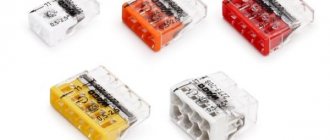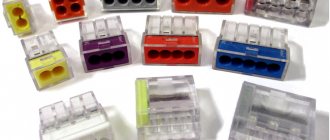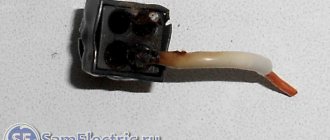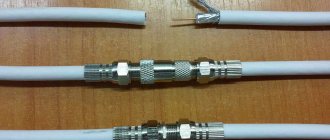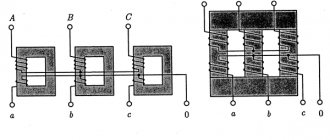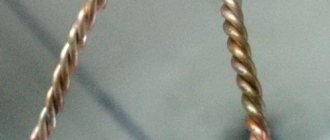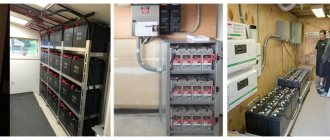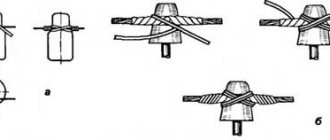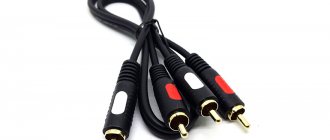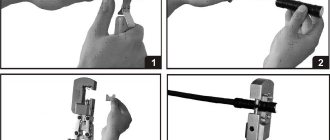Types of terminal blocks according to housing material
At a minimum, the supporting part is made of dielectric. Based on its characteristics, the manufacturer selects the minimum permissible distances between the terminals to prevent air breakdown.
- Ceramics. This material has a lot of advantages, and, perhaps, one drawback: it is fragile. The ceramic terminal block is used in electrical installations with intense temperature conditions: heating devices, powerful power busbars (natural heating of the conductor is allowed). In addition, ceramics are used when organizing wiring near mechanisms that have a high operating temperature. The only limitation is that there should be no vibration or shock loads in the places where ceramic terminal blocks are installed.
- Polypropylene. Durable, relatively plastic material. It resists shock loads and vibration well and does not crack when deformed. However, its temperature and dielectric characteristics do not allow use in high-voltage networks with neutral and phase wires located nearby. Therefore, polypropylene products are usually used on one line (either zero or phase), and are limited to 600 volts. Another application is terminals for connecting household lighting devices. In such blocks, zero and phase can coexist.
- Polyamide. Durable, non-flammable material with excellent characteristics. At the same time relatively expensive. Used in pads that have high performance requirements. Due to its resistance to external influences, polyamide can be used both in load-bearing elements and in the manufacture of a durable outer casing.
- Carbolite. Perhaps the best non-flammability characteristics, and the dielectric of this material is good. Withstands static loads and vibration, but may crack upon impact. Carbolite terminal blocks are used in any electrical installations, except for heating elements. Except that the cases they make are not very durable. Carbolite blocks are widely used in household lighting equipment. Almost every second chandelier is connected using such a switch.
- Polyvinyl chloride (PVC). Blocks for mass use for low-current connections. Again, household appliances and lighting. The material is non-flammable, quite durable, but deforms when heated. The main advantage is the low price. For this reason, many unscrupulous electricians use these blocks for other purposes when assembling powerful electrical installations. Such “savings” often lead to breakdowns of switchboards and electrical equipment failures. In addition, such pads are available in a convenient form factor: the line can be easily divided into the required number of contacts.
- In the manufacture of terminal blocks for wires, textolite and ebonite are also used. But these are piece products for certain projects: the material is too expensive.
Screw type terminal blocks
Screw terminal blocks are one of the most common types. They are a brass sleeve with two bolts in a plastic case. Contact is ensured by bolt pressure. The body can be made of different materials - polyethylene, polyamide and polypropylene. With their help, you can connect wires with a cross-section from 0.5mm2 to 35mm2.
The advantages of screw pads include:
- No special tools required (only a screwdriver is needed).
- Reusable.
- Possibility of using the required number of segments.
Screw pads also have a number of disadvantages:
- High contact resistance.
- Low reliability (weakened by vibration).
- Restrictions on wire material.
- Installation duration.
- Requires some skill to tighten.
- Annual maintenance required.
It is not advisable to connect aluminum wires with such terminals. They have increased “fluidity”; the connection weakens over time. To avoid heating due to an increase in contact resistance, it is necessary to tighten them regularly. This creates inconvenience during operation.
Certain problems also arise with multi-core wires. With screw connections, high-quality installation can only be performed using special tips or blocks with a pressure plate. Otherwise, there is a risk of damage to the cores when tightening the screw.
Thus, single-core copper wires are most suitable for this design.
Installation with a screw connection is very simple:
- Cut off the required number of terminals from the block (with a regular knife).
- Strip the insulation of the connected wires (5-12mm).
- Insert the stripped ends of the wires into the terminals;
- Tighten the screws.
It's easy to deal with
The main thing is to be careful when tightening screws and choose quality terminal blocks
When choosing, you need to pay special attention to the manufacturer of the product. Today there are products of different brands on sale
It is better to use products from such well-known manufacturers as Legrand, ABB, Tridonic, Werit.
Product prices depend not only on technical characteristics, but also on the manufacturer:
| Manufacturer | Type | Characteristics | Price, rub |
| Tridonic | EKL 0 S | 450V,32A,12pairs,4mm2, white. | 55,64 |
| Legrand | Nybloc 034211 | 250V,24A,12pair,4mm2, black. | 209,00 |
| Korner | OK 432-PLP-BN | 450V,32A,12pairs,4mm2, white. | 118,68 |
| Tridonic | EKL 3 S | 750V,76A,12pair,16mm2, white. | 158,78 |
| Legrand | Nybloc 034211 | 250V,76A,12pairs,16mm2, white. | 540,49 |
| Werit | 112-11521 | 250V,63A,12pairs,16mm2, white. | 299,23 |
Varieties and types of clamps.
Products are divided according to the following criteria:
- According to the level of design - single-tier and multi-tier products, of which multi-level types are considered the most complex.
- Depending on the location of the contacts - straight and corner connectors.
- Depending on the design of a particular wire, since many cores differ in their internal structure, and, accordingly, their connection points should also have characteristic differences.
- By type of fastening - screw, spring, clamp, end and end types.
Some of the most common types of classification will be discussed in more detail within the framework of this article.
Terminal clamps.
Screw terminals with a pair of metal contacts enclosed in a dielectric housing. Wires can be connected at several points - two or more. Using the blocks, you can connect when performing household electrical work. They are also used in junction boxes.
You may be interested in How to extend the antenna cable
Important! The main feature of the product is the simplicity of its design and high level of reliability.
Terminals
Scotch-lock.
A product called adhesive tape has an impressive number of advantages compared to other types of clamps. With its help, you can easily connect to a line or connect conductors without using special tools. The scheme of operation is to create fixation using compression in a knife-type contact. Electrical adhesive tape also has a reliable and safe dielectric housing, which allows you to create a completely insulated contact.
The material most used in the production of clamps is polypropylene. Flame retardant nylon may also be used. A U-shaped contact is placed in the product body, cutting through the insulation and making contact. Also, a special hydrophobic composition is poured into the body, the addition of which is a way to protect the connection point from any influences. The operating principle of the design is in many ways reminiscent of piercing clamps used when working with SIP wires.
Important! The installation of adhesive tape must be carried out in several stages: first, the cable is inserted, and then the clamp is applied.
What does Scotch Lock look like?
PPE caps.
The PPE cap is a special design, the purpose of which is also to provide a connection point for two or more wires. The product includes two components: the cap itself and a steel spring. The material used in the manufacture is a special electrically insulating, non-flammable plastic that is resistant to temperature influences and can also withstand high voltage. The spring structure in the form of a cone is created from metal, the turns of which compress the electrical wire.
Products are classified according to the presence of ears, which, in principle, is not a particularly important difference. Ear caps are a little easier to use, but they also take up a little more space. Connecting using caps is very convenient, and the work does not require special skills or effort.
PPE caps
Spring clamps for connecting wires.
Spring clamps are structures used to connect wires and are made from all kinds of polymer metals. The main contact surface consists of two brass surfaces. The first is rigidly fixed to the body of the product, the second - to its moving part.
You may be interested in this Features of stranded wire
At the time of installation work, the movable area is raised, a wire is threaded into the resulting opening, after which the structure returns to its reverse position.
Important! At the moment of closing, the spring creates a certain pressure on the core, the self-clamping mechanism creates a reliable fastening and allows you to connect any device to the network.
Spring clamps
Rules for choosing self-clamping terminals
The main rule for a potential buyer of self-clamping terminal blocks is, perhaps, the mandatory verification of the product for authenticity. There are a lot of counterfeit goods on the commercial market, marked with the German brand - the manufacturer Wago itself warns about this.
The cost of such products is reduced, which naturally attracts the buyer. However, this kind of savings can result in troubles when operating the assembled circuits.
Meanwhile, without unnecessary warnings, it should be obvious that a counterfeit product is a significant reduction in quality. How to choose the right wire connectors without fear of getting a fake? In principle, everything is quite simple. You just need to be more careful when choosing self-clamping terminals for installation.
A branded product traditionally has the Wago logo printed in a clear font, usually on the top or side of the case. Also on the side are the main parameters - voltage and current.
This is what a branded product released under the Wago brand looks like. Counterfeit terminal blocks, as a rule, do not contain such a seal, or contain a partial one applied with low quality
The color of the insulating material of branded products is distinguished by a uniform, clear color. There is a mini connection instruction on the back/side of the terminal block.
When compared with Chinese counterfeit goods, terminal blocks, as a rule, do not have any of the above-mentioned differences. In addition, the fake is immediately distinguished by the blurred color of the insulator, often multi-colored.
Of course, the main points of choice are the purely technical parameters of self-clamping terminal blocks. In particular, the operating voltage and permissible conducted current.
If the mounted circuits are designed for operating voltages that exceed the capabilities of the terminal blocks, then the application becomes impractical and, moreover, dangerous.
You will learn about the color of the connected wires from the following article, the contents of which we recommend that you familiarize yourself with.
Types of terminal blocks by contact arrangement
The simplest block is a metal strip with a series of contact clamps. Designed to combine multiple wires with the same rating. For example, zero bus or grounding.
The main wire comes to one of the screw terminals, and the entire block acquires the necessary potential.
The feed-through type is designed for linear connection of wires. Often used for splicing different metals (copper and aluminum).
There is another type of feed-through terminal block.
The main principle is that parallel conductors are separated by a dielectric.
Barrier blocks are similar to pass-through blocks, but they provide more reliable protection against short circuits of adjacent wires. The dielectric extends beyond the contact plane and additionally protects the block from accidental short circuit (for example, a conductive element falling onto the terminals).
Where and how you can buy inexpensive terminal blocks for wires: prices, market overview
| Photo | Brand/Model | Product type | price, rub. | Peculiarities |
| DINKLE/DT126VP-03P | screw | 26÷37 | Operating current up to 8 A. Maximum wire cross-section – 2.1 mm2. | |
| TDM/SQ0510—0002 | screw | 27÷34 | For 12 contacts. Conductor cross-section – up to 4 mm square. | |
| TDM/SQ0527—0012/CR-413 | connection terminal | 35÷40 | Analogue of "Vago". The price is for a model with three slots. | |
| Schneider Electric/NSYTRV42BL | screw pass-through | 68÷85 | Rated current – 32 A. The clamps are made of copper alloy. | |
| Legrand/004803 | screw | 180÷190 | No insulation. | |
| WAGO/2273 | Compact | 21÷45 | The transparent part of the housing simplifies visual inspection of wire placement. |
Basic methods of connecting wires
Connection methods between wires and cables are selected depending on the metal used, thickness, number of cores, type of insulation and other factors. It is also necessary to take into account what the conditions of further operation will be.
Twist
The most common and simple method is twisting, which does not require any special tools. A strong and reliable connection is made with just a knife and pliers. It is enough to strip each core by at least 50 mm, clamp them with pliers, and then twist them together with rotational movements. The twist is wrapped in any direction and insulated.
Electrical tape should not be skimped on: it should be wound not only at the twisting site, but also on the wires themselves, extending 20-25 mm onto them. In addition to electrical tape, heat-shrinkable tubing can be used. Such a connection lasts a very long time, it tolerates vibration well and is most suitable for use in moving mechanisms. However, this method is not suitable for connecting copper and aluminum wires that have different structures and different cross-sections.
Soldering
Soldering is considered a more reliable method, ensuring good conductivity and safety. Tinning is done with rosin, and tin or lead is used for soldering copper wires. Aluminum wiring is soldered with zinc-based compounds with the addition of tin, aluminum or copper. The wires are pre-twisted, then rosin is first applied to this place, and then heated solder. At the end of the work, the connection is isolated. The only drawback of this method is the fragility of the soldering joints and their poor resistance to vibration and mechanical stress.
Terminal blocks
The most modern and progressive method is connection using terminal blocks. Such electrical connectors significantly facilitate and speed up wiring installation and confidently replace traditional switching methods. The main advantage is the ability to connect conductors made of dissimilar materials.
Thanks to the design of the terminals, direct contact between copper and aluminum is eliminated, as a result, the formation of corrosion, as happens with conventional twisting, is completely eliminated. Almost all connectors for electrical wires are made of brass alloy, and can be structurally spring, screw or knife. The internal cavities of some models are filled with a special gel, which provides additional anti-corrosion protection for the contacts.
Causes of malfunction and main elements
Broken wires are a common occurrence and most often occur unexpectedly.
Most popular problems:
- Poor contact with various equipment;
- Short-term loss of light;
- Strong heat generation in some areas.
To prevent breakdowns, it is necessary to detect the problem in a timely manner and take appropriate measures to eliminate it. For fixation, it is best to use terminal blocks, as they can provide a person with reliability and durability. In addition, they are easy to install, which will allow you to use them at home without any problems.
Today in stores there are hundreds of varieties from top companies, which differ in price and technical parameters. But besides this, the difference may lie in the method of fixation.
All terminals consist of two elements:
- Plastic case, which is made in the form of cells;
- A brass pipe with a threaded hole on both sides.
When fixing the cable, it is important for a person to remember that the pipe may differ in diameter, especially if you plan to connect thick wires. Therefore, you first need to choose the right size.
This installation can be used in any area: from household to car wiring repair, which makes the product universal. Most often, the element is used when connecting a lamp with a short conductor.
It is important to know the negative sides of such fixation:
- Self-clamping options are designed for use with specific cables. They are not suitable for connecting elements with a larger cross-section.
- If a person bought disposable terminal blocks, then he should remember that they cannot be used to fix flexible wires, since they are not intended for this.
- It is also worth understanding that the product is afraid of exposure to high temperatures. If it is constantly used in such an environment, then over time the spring will weaken, causing the contact pressure to decrease and the connection density to be lost.
- The terminals provide good fixation, but if you have the opportunity and experience to carry out soldering, then it is better to do it, it will be much more reliable.
The main advantage of the element is the ability to connect copper and aluminum wires. In addition, by using terminal blocks, the chance of contact oxidation is reduced significantly. This became possible due to the fact that the screw clamps the cable so tightly that contact between the cores becomes impossible.
Permanent connection
This installation method is performed in the same way as using a bolt and nut, but using a special tool - a riveter. The operating principle of the riveter lies in the rivet design.
It is a hollow aluminum tube with a thickening at one end. A metal rod with a head is inserted into the rivet. When the rod is pulled through the rivet, it forms a bulge at the other end of the rivet, while simultaneously expanding the tube itself somewhat.
When a certain maximum force is reached, the rod breaks off, leaving a clean, formed rivet. If you do not take into account the cost of the tool, the price of an individual rivet makes this type of installation the cheapest after twisting. There is only one drawback - such a connection is disposable and permanent.
Another option for permanent connections is obtained by using special tinned copper connecting tubes. Such tubes are produced in several diameters to suit the most common diameters of the wires being connected.
The stripped ends of the wires are inserted into the opposite ends of the tube and the latter is crimped with a special device. Together with twisting, this is the most compact type of connection of conductors.
This method can be used only if the diameter of the wires is the same and exactly matches the diameter of the tube.
Types of endings
Terminal blocks are often classified by terminal type. The type of connection technology selected depends on the application, environment, and wire size or AWG cable size. Terminal blocks are available in several types.
- Screw clamp. Screw terminals are the most common connection type. The wires are inserted into the block and pressed against the conductive busbar. The bolt is then tightened to form the connection.
- Spring clamp. A spring clamp mechanism is used to hold the wire in position. A screwdriver is inserted into the clamp, then a wire, and when the clamp is released, it holds the wire in place. These types of clamps are very safe and ideal for high vibration environments.
- Push-in connection. Push-in technology allows you to simply insert the wire into the connector for connection. Plug-in types allow the use of solid and stranded conductors with the addition of a cable lug. They are assembled quickly and without tools.
Existing types of terminal blocks for connecting wires
The terminal block is a mechanical clamp located in a plastic housing. The terminal, depending on the type of clamp, may have metal plates, springs for fixing the wire, or screws.
There are different types of wire connections using a terminal block.
Types of terminal blocks by type of wire clamp:
- Knife clamps;
- Screw terminals;
- Spring clamps.
The knife type of connections is very convenient. When making a connection, you do not need to strip the contacts; you just need to apply some force to firmly fix the wire in a special knife. These terminals are also called plug-in or automotive terminals. Using a screw type of connection, select suitable pads and the required cell sizes, insert the core inside and then clamp it with screws
When applying force, it is important not to break the wire. After about a year, you will need to check whether the screw in the connection has come loose and, if necessary, tighten it
And another disadvantage of this connection is that only two wires can be connected without problems. The most convenient connection option is a spring connection. When making this connection, you just need to insert a wire stripped of insulation into the terminal block. The lever located there will tighten the core and will not release it back; you can remove the core by pulling the lever back, but when you reconnect, the quality of the connection deteriorates. The characteristics of spring-type clamps limit their use to wires with a cross-section of no more than 2.5 mm2 and a current limit of up to 40A.
Types of terminal blocks
Knowing the principle of operation of terminal blocks, you can immediately understand what exactly you need to buy. Here, manufacturing materials, mounting and installation methods, as well as the design of the device play a big role.
Screw terminal block
The most common types of terminal blocks are:
- screw. Such terminal blocks are also called barrier or mounting (construction) terminal blocks. This type is the most popular in the field of electrical engineering, as it has increased reliability and ease of operation and installation. They are often used to connect electrical outlets in a home or to hold two pieces of one wire in place while running it. Reliability is ensured by special screw clamps, hence the name. One caveat is that they are not used with aluminum conductors;
- clamping Other names are crimp, spring or self-crimp. The essence is the same - a spring is used to fix the wire or cable, which means that the clamping occurs without any tools or additional means. It is enough just to strip the insulation, insert the conductor into the hole until it stops and press it with a lever with a spring. Removing it is also simple: the lever is turned back to its original position. The most modern options have mechanisms for self-stripping of cables and their self-clamping. They gained popularity due to their lightweight plastic housings, which do not require additional insulation, as well as high-quality brass clamping plates;
- used in junction boxes. Boxes are places where there are sometimes so many connections that there is even nowhere to plug the terminal block. Special types of plastic blocks with a large number of holes for fixing wires fit perfectly there. They also have a spring mechanism and a special current bus. To connect, also clean the wire, insert it all the way and fix it with a lever on the spring until it clicks;
- knife terminal blocks. They have found their application in grounding systems and neutral conductors. They allow you to quickly insert a branch into the main highway. The advantage is that the wires do not need to be stripped. It is enough to insert them into the terminal blocks and perform crimping with a special lever. The design allows you to quickly complete installation work and create a high-quality and reliable connection.
You might be interested in this Features of the VBBShV cable
Terminal blocks are often used in distribution boxes
What are terminals?
Terminal clamps are electrical devices used to connect cables and wires. The design of the terminals includes 2 or more contacts made of conductive metal, equipped with fastenings for conductors. The terminal block housing is made of dielectric material to prevent short circuits or electric shock.
Conducting plates are made of copper or copper-based alloys. The minimum resistance is ensured by tinning, that is, coating the plate with a layer of tin or tin alloys. Varieties of terminal blocks are equipped with springs; a copper plate is in contact with the wire; the spring itself is usually made of chromium-nickel steel.
Plastic or porcelain is used as the insulating material of the housing. The material is selected taking into account resistance to deformation and high temperatures. The use of terminal blocks in installation has become widespread, and gradually soldering of wires fades into the background, giving way to terminal connections. Using terminals is more economical than soldering and is significantly more reliable. The terminals have proven their effectiveness in connecting wiring with copper and aluminum conductors, providing a high-quality connection and protecting the cable from mechanical stress during installation.
RCD connection diagram: instructions, methods, errors
What is an RCD in electrical engineering: types, principle of operation
What is a terminal block
A regular terminal block is a special connector for solid and flexible wires or cables. Such devices are used in completely different systems, but their purpose is the same - to create high-quality contact between two wires or to create a fork without the use of additional tools or insulation.
Pad options
A simple but popular twisting today is not recognized even by the PUE and cannot be used by real specialists for safety reasons. Such connections significantly damage the contact, contribute to the destruction of conductors and are a very vulnerable place for a fire. This happens due to heating of the contact. There is no need to talk about unsafety due to the possibility of electric shock, since this is obvious. To ensure reliable electrical contact and simplify its maintenance, terminal blocks are used.
Types of terminal blocks
Power connecting electrical blocks (or simply terminal blocks) are special devices with a special contact strip. The wires are attached to it by using connecting clasps in pairs. Typically, such clamps are made hermetically sealed, isolated from external factors and have good protection from mechanical and other irritants.
For your information! Terminal blocks have recently been almost universally used in various electrical installation systems, in which they play one of the main roles. Their task is to quickly install and dismantle a safe wiring connection that has the electrical fastening reliability required by the PUE.
Classic clamp terminal block
Also, heat-resistant pads and ceramic attachments stand out against the background of simple clamps. They are not exposed to aggressive chemical environments and are not destroyed by moisture. Porcelain and steatite ceramic pads are used to create reliable contacts of conductors exposed to fairly high temperatures.
You might be interested in Homemade heating cable
Vagov connectors
If an ordinary block made of polyamide or another type of plastic melts already at 150 °C, then a ceramic one can easily withstand temperatures up to 350 °C, and begins to change its properties only at 500 °C.
Types of terminals
Terminal blocks
there are cells in the body
The advantages of such terminal blocks are that different materials can be connected. For example, a terminal connection of aluminum and copper or large cross-section and small. This is very convenient, because the connected aluminum and copper wires oxidize, which causes inconvenience during further operation. Connecting terminals do not allow direct contact of wires with each other. When choosing, you need to know the current that will flow through the wires; it must be less than the rated current of the terminal block. Reliability, of course, is less than with soldering, but it is very convenient, and installation time is also reduced.
According to the design of the connection of wires with a terminal block, there are the following types:
- screw;
- spring;
- knife
Screw terminal blocks
Installing the terminal block does not cause any trouble even for people who are far from electricians. Connecting the wires is very easy: you need to select a block with the required mesh size, insert the wires inside and tighten them with screws. You need to tighten it with a fairly strong force. You need to feel the moment when the screw is already tightened so as not to damage the core. After about a year, it is necessary to check the connection and tighten the screw if necessary. This refers to the disadvantages. There is also no way to connect three wires.
You can also use a rivet instead of a screw. But then you need a special tool, and you need to take into account that the structure is then difficult to disassemble. Place an aluminum wire on the rivet, then a spring washer, a copper wire and a flat washer. This structure is compressed with a special tool. If the same materials are used, then there is no need to place a washer between them. But the last washer should be the same.
Spring terminals
The lever will tighten the wire
The disadvantages include the fact that you have to constantly select the terminal block according to the number of connections. That is, if it is necessary to connect three wires, then you need a terminal block that provides for the connection of three wires. If there are more than six wires, then you will have to combine the terminal blocks with each other. Electrical experts recommend using spring terminal blocks to separate phase and zero
It is also important to remember that if you disconnect the lever once, then the reliability of the connection will deteriorate when clamped again.
Blade terminals
Knife terminals are also easy to use. When connecting, there is no need to pre-clean the contacts. But force must be used, because you need to carefully fix the core in a special knife. Often such terminals are called plug-in terminals and are used in cars, for example, when connecting to a headlight lamp.
Terminals for distribution boxes
Terminal blocks are also used in distribution cabinets. They are presented in the form of a polycarbonate case with a copper platform on which holes for connection are located. They also have steel springs to secure the wires. It is very convenient to use terminal blocks when you need to connect the ground wires into one common one. This type of terminals is suitable for connecting wires of various types. For ease of installation, data with the value of the rated current, wire diameter, and maximum permissible loads are printed on the case. A paste is also provided to prevent overheating.
Fused terminals
Manufacturers have also provided additional protection for the electrical wiring and equip the terminals with a fuse. This type of connection has a holder that holds a standard fuse. Very convenient when operating electrical equipment without a built-in fuse.
Terminal blocks for lighting
Terminal blocks for lighting can significantly simplify and reduce installation when laying electrical equipment for lighting. The case allows you to withstand temperatures of about 105 degrees, copper contacts make it possible to improve conductivity, and springs securely fix the cores. Such terminal blocks are sometimes made with a special paste that protects the connection from oxidation and prevents the conductors from overheating.
Terminals for luminaires
When installing chandeliers, floor lamps or fans together with a chandelier, you can use a terminal block for lamps. It is very convenient to connect up to five wires simultaneously. They are equipped with self-clamping contacts, which facilitates installation and installation, while also reducing the amount of consumables. All terminals are marked and have convenient latches that allow for quick installation.
What types of pads are there?
There are several types of terminal blocks, differing in withstand voltage, method of fixation, purpose, functionality and many other performance characteristics.
The most common division is the following:
- By installation method (for connecting individual wires, for a printed circuit board, for G and DIN rails, for cross-modules);
- If possible, cutting off the required number of terminals (solid, connected by plastic plates or special clamps, connectors);
- According to the method of fixing the wires (straight, angular).
However, the division of blocks according to the clamping structure, that is, the method of connecting the wire, is considered decisive:
- Screw terminal blocks use a clamp with screws that are tightened after the conductor is inserted into the hole. The “advantages” of the screws include cost-effectiveness, reliable fixation, and the ability to regulate the pressure force, while the “disadvantages” include the need to control the position of the wire and the impossibility of using them for stranded conductors and aluminum conductors.
- Detachable ones consist of two parts, where one is attached to the panel, and the second directly to the wire.
- Spring or push terminal blocks are also called screwless terminal blocks, since the fixation occurs through a special lever, after pressing which the structure “closes”.
Design and assembly of the terminal block
Each DIN rail terminal block is fixed with a latch, so that one fits tightly to the other. There should be no gap between them. Then the necessary jumpers, end insulators and clamps are installed. Don't forget about the labeling. The wires are connected taking it into account and in accordance with the diagram. If the terminal block is screw, then the bolt must be loosened before operation. During installation work, the reliability of all contacts must be checked.
Why do you need an end insulator?
On the right side of a separate terminal block cell you can see the current-carrying elements of the clamping mechanism. The manufacturer deliberately leaves them open and does not make an additional partition. This is explained by material savings and a reduction in the overall dimensions of the product. When the terminals are assembled on a DIN rail, each right-handed one automatically covers the current-carrying parts of the left-handed one. Those. one terminal block is a protective cover for the other, so for the entire line except the last one.
End insulator
To protect the rightmost terminal block from the environment and accidental human touch, end insulators are used. They perform the function of a side cover and allow you to obtain a row of terminal blocks that is completely insulated on all sides.
Important! End insulators and terminal blocks should be purchased from the same manufacturer. Otherwise, they may not match in shape.
The calculation must be made based on the fact that one insulator is required for one line of terminal blocks.
Terminal retainer or stopper
When installing or tightening screw terminals, individual cells may begin to move apart on the DIN rail to the sides. As a result, cracks and gaps form in the structure. Through them, dust and moisture from the air can get inside. This cannot be allowed to happen. To solve this problem, clamps or terminal stops are used. Such parts are installed at both ends of the ruler. You should not neglect them, because this may negatively affect the quality of installation and further operation of the electrical panel or installation.
Screw jumpers
To electrically connect adjacent cells of the terminal block to each other, you can use a short connecting wire. But such a solution is impractical and takes up too much precious space. It is much more convenient to use screw jumpers. This is done if there is one incoming supply wire, and it is necessary to distribute many outgoing ones from it to consumers, i.e. get branched. Screw jumpers are a metal strip with holes that fit onto a terminal block. They are available in various lengths. If desired, they can be shortened with pliers to the desired size.
Sealing of terminals
When commissioning an electrical panel, it may be necessary to prevent unauthorized access to it. Such requirements are often put forward by electricity supply organizations. In this situation, protective covers made of transparent plexiglass are installed on the rows of terminal blocks. They are held in place by nuts with holes for attaching seals. Only controllers of the above organizations have the right to install/dismantle the latter.
Attention! The integrity of the seals should be monitored and unauthorized persons should not be allowed to access them. A broken or damaged seal may result in sanctions from the electricity supplier
Types of Terminal Blocks
Terminal block for DIN rail
Terminal connectors for wires are grouped according to a number of characteristics, such as:
- Purpose;
- Installation methods;
- Row;
- Execution;
- Type of connected conductor;
- Type of clamp.
Purpose
CCs differ in purpose:
- connection of wires;
- on a printed circuit board;
- on DIN rail;
- cross-modules.
Connecting wires
This is the most common connector design. These are mainly screw, knife and lever terminal blocks. The ends of the wires are inserted into the holes of the clamps, both on both sides and on one side.
To PCB
To connect low-voltage power, blocks with screw terminals are mounted on the board. In addition to the fact that the wires are fixed in the CC, they are also secured with special clamps.
QC on PCB
DIN rail
Universal electrical devices come in the form of stationary modules and prefabricated terminal blocks. The first ones have a completed design. The second type of control panel consists of individual modules, from which it is possible to create different design positions for distribution terminals. When installing connections of numerous wire lines in one node, the use of a DIN rail is the most rational solution.
Cross modules
The use of cross-modules allows you to conveniently and reliably perform electrical installation work in distribution cabinets and switchboards. The main function of the cross-module is to divide power from one energy source into several outgoing lines.
Installation methods
According to the method of installation of connections, CCs are divided into the following types.
Screw
Metal clamps are built into the screw terminal block housing. These are horizontal sleeves with a vertical screw. The bare end of the wire is inserted into the hole and the core is clamped on top with a screw. On the other side of the block, another conductor is inserted into the steel sleeve, which is also clamped. A tight contact is formed. Steel is indifferent to copper and aluminum. Therefore, ZVI screw terminal blocks are used to connect wires made of dissimilar metals, without fear of causing corrosion processes.
Clamping
CCs of this type fix conductors with lever clamps. The wire is inserted into the mounting hole and the lever presses the core to the sleeve. The advantages of this connection are the quick installation and dismantling of wires.
Lever terminal blocks
There are one-piece models with a spring lock inside the sleeve, which prevents the wire from coming out. As a rule, this is a single-use CC.
Barrier
Designed for wires with high current. The pads are equipped with screw fasteners.
DIN rail
Above in the text there is a description of this device.
Rowing
According to the row, the pads are divided into single-row, two- and three-row pads. There are also multi-tiered structures.
Execution
The pads come in straight and angled configurations. For the former, the directions of the cable lines do not change. Angle blocks are used at turns when the wires cannot be bent. The outgoing conductor is perpendicular to the oncoming conductor. The wire terminals are located at right angles.
Note! One of the most common terminals is detachable crimp connectors. One terminal fits into the connector of another contact. They are called "mom" and "dad". The receiving tip has lateral oval bends, and in the middle there is a spring-loaded petal in the opening. To disconnect the wires, the tongue is bent, and the “father” is easily removed from the “mother”.
Connected conductor type
These are devices for single-core and double-core flexible conductors.
Type of clamp
According to the type of clamp, the following types are distinguished:
- screw;
- spring;
- clamping cage;
- end;
- knife;
- terminal
